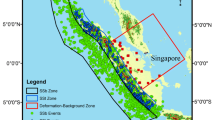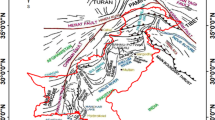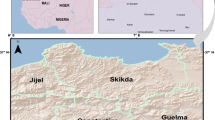Abstract
Earthquake Monitoring Center (EMC) at Sultan Qaboos University (SQU) initiated evaluating the seismic hazard in the Sultanate of Oman in 2009. EMC has produced the first probabilistic and deterministic seismic hazard maps for Oman in 2012 and 2013, respectively. In the current study, the probabilistic seismic hazard assessment (PSHA) is revisited to provide an updated assessment of the seismic actions on the Sultanate. The present study has several advantages over its predecessor: using an updated homogeneous earthquake catalogue, recently developed seismic source model; inclusion of epistemic uncertainties for the source models, recurrence parameters, maximum magnitude, and more recent and applicable ground-motion prediction equations (GMPEs). Epistemic uncertainties were treated using a combination of the best available databases within a properly weighted logic tree framework. Seismic hazard maps in terms of horizontal peak ground acceleration (PGA) and 5% damped spectral accelerations (SA) at the bedrock conditions (VS = 760 m/s) for 475- and 2475-year return periods were generated using the classical Cornell-McGuire approach. Additionally, uniform hazard spectra (UHS) for the important population centers are provided. The results show higher values at the northern parts of the country compared to the hazard values obtained in the previous study.












Similar content being viewed by others
References
Akkar S, Bommer JJ (2010) Empirical equations for the prediction of PGA, PGV and spectral accelerations in Europe, the Mediterranean region and the Middle East. Seismol Res Lett 81:195–206
Aldama B, Bommer JJ, Fenton CH, Staford PJ (2009) Probabilistic seismic hazard analysis for rock sites in the cities of Abu Dhbi, Dubai and Ra's Al Khymah, United Arab Emirates. Georisk 3:1–29
Al-shijbi Y, El-Hussain I, Deif A, Al-Kalbani A, Mohamed AME (2019) Probabilistic Seismic Hazard Assessment for the Arabian Peninsula. Pure Appl Geophys 176:1503–1530
Ambraseys NN, Melville CP (1982) A history of Persian earthquakes. Cambridge University Press, Cambridge
Ambraseys NN, Melville CP, Adams RD (1994) The seismicity of Egypt, Arabia and Red Sea. Cambridge University Press, Cambridge
ArRajehi A, McClusky S, Reilinger R, Daoud M, Alchalbi A, Ergintav S, Gomez F, Sholan J, Bou-Rabee F, Ogubazghi G, Haileab B, Fisseha S, Asfaw L, Mahmoud S, Rayan A, Bendik R, Kogan L (2010) Geodetic constraints on present-day motion of the Arabian Plate: Implications for Red Sea and Gulf of Aden rifting. Tectonics 29:TC3011
Atkinson GM, Boore DM (2003) Empirical ground-motion relations for subduction-zone earthquakes and their application to Cascadia and other regions. Bull Seismol Soc Am 93:1703–1729
Atkinson GM, Boore DM (2006) Earthquake ground-motion prediction equations for Eastern North America. Bull Seismol Soc Am 96:2181–2205
Baker C, Jackson J, Priestley K (1993) Earthquakes on the Kazerun line in the Zagros Mountains of Iran: strike-slip faulting within a fold-and-thrust belt. Geophys J Int 115:41–61
Berberian M (1995) Master ‘blind’ thrust faults hidden under the Zagros folds, active basement tectonics and surface morphotectonics. Tectonophysics 241:193–224
Beyer, K., and Bommer, J.J., (2006) Relationships between median values and between aleatory variabilities for different definitions of the horizontal component of motion. Bulletin of Seismological Society of America 96, 1512-1522, Erratum (2007) 97, 1769.
Bommer JJ, Scherbaum F, Bungum H, Cotton F, Sabetta F, Abrahamson NA (2005) On the use of logic trees for ground-motion prediction equations in seismic hazard analysis. Bull Seismol Soc Am 95:377–389
Bosworth W, Huchon P, McClay K (2005) The Red Sea and the Gulf of Aden Basins. J Afr Earth Sci 43:334–378
Burkhard M, Grunthal G (2009) Seismic source zone characterization for the seismic hazard assessment project PEGASOS by the Expert Group 2 (EG 1b). Swiss J Geosci 102:149–188
Campbell K (2003) Prediction of strong ground-motion using the hybrid empirical method and its use in the development of ground-motion (attenuation) relations in Eastern North America. Bull Seismol Soc Am 93:1012–1033
Chiou BS, Youngs RR (2008) An NGA model for the average horizontal component of peak ground motion and response spectra. Earthquake Spectra 24:173–215
Coleman RG (1993) Geologic evolution of the Red Sea. Oxford Monographs on Geology and Geophysics 24. Oxford University Press, Oxford
Coppersmith KJ, Youngs RR (1986) Capturing uncertainty in probabilistic seismic hazard assessments within intraplate tectonic environments. In: Proceedings of the Third US national conference on earthquake engineering, vol 1, pp 301–312
Cornell CA (1968) Engineering seismic risk analysis. Bull Seismol Soc Am 18:1583–1606
Cornell CA (1971) Probabilistic analysis of damage to structures under seismic loads. In: Howells DA, Haigh IP, Taylor C (eds) Dynamic waves in civil engineering. Proceedings of a conference organized by the Society for Earthquake and Civil Engineering Dynamics. New York, John Wiley, pp 473–493
Cornell CA, Vanmarcke EH (1969) The Major Influences on Seismic Risk. In: Proceedings of the Fourth World Conference of Earthquake Engineering, 1. Santiago, Chile, pp 69–83
Deif A, El-Hussain I (2012) Seismic moment rate and earthquake mean recurrence interval in the major tectonic boundaries around Oman. J Geophys Eng 9:773–783
Deif A, El-Hussain I, Al-Jabri K, Toksoz N, El-Hady S, Al-Hashmi S, Al-Toubi K, Al-Shijbi Y, Al-Saifi M (2013) Deterministic seismic hazard assessment for Sultanate of Oman. Arab J Geosci 6:4947–4960
Deif A, Al-Shijbi Y, El-Hussain I, Ezzelarab M, Mohamed AME (2017) Compiling an earthquake catalogue for the Arabian Plate, Western Asia. J Asian Earth Sci 147:345–375
Delavaud E, Cotton F, Akkar S, Scherbaum F, Danciu L, Beauval C, Drouet S, Douglas J, Basili R, Sandikkaya MA, Segou M, Faccioli E, Theodoulidis N (2012) Towards a ground-motion logic tree for probabilistic seismic hazard assessment in Europe. J Seismol 16:451–473
DeMets C (2008) Arabia's slow dance with India. Nature Geoscience 1: 10–11, der Schweiz, PhD thesis, ETH-Zurich.
Douglas J, Akkar S, Ameri G, Bard PY, Bindi D, Bommer J, Bora SS, Cotton F, Derras B, Hermkes M, Kuehn NM, Luzi L, Massa M, Pacor F, Riggelsen C, Sandıkkaya MA, Scherbaum F, Stafford PJ, Traversa P (2014) Comparisons among the five ground-motion models developed using RESORCE for the prediction of response spectral accelerations due to earthquakes in Europe and the Middle East. Bull Earthq Eng, Springer Verlag 12:341–358
El-Hussain I, Deif A, Al-Jabri K, Toksoz N, El-Hady S, Al-Hashmi S, Al-Toubi K, Al-Shijbi Y, Al-saifi M, Kuleli S (2012) Probabilistic seismic hazard maps for Sultanate of Oman. Nat Hazards 64:173–210
El-Hussain I, Deif A, Al-Jabri K, Mohamed AME, Al-Rawas G, Toksöz MN, Sundararajan N, El-Hady S, Al-Hashmi S, Al-Toubi K, Al-Saifi M, Al-Habsi Z (2013) Seismic microzonation for Muscat region, Sultanate of Oman. Nat Hazards 69:1919–1950
El-Hussain I, Al-Shijbi Y, Deif A, Mohamed AME, Ezzelarab M (2018) Developing a seismic source model for the Arabian Plate. Arab J Geosci 11:435
Giardini D, Grunthal G, Shedlock KM, Zhang PZ (1999) The GSHAP global seismic hazard map. Ann Geofis 42:1225–1230
Gutenberg B, Richter CF (1956) Magnitude and Energy of Earthquakes. Ann Geofis 9:1–15
Hamdache M, Peláez JA, Talbi A, Mobarki M, López Casado C (2012) Ground-motion hazard values for Northern Algeria. Pure Appl Geophys 169:711–723
Hessami K, Koyi H, Talbot C (2001) The Significance of the Strike-Slip Faulting in the Basement of the Zagros Fold and Thrust Belt. J Pet Geol 24:5–28
Hessami K, Nilforoushan F, Talbot CJ (2006) Active deformation within the Zagros Mountains deduced from GPS measurements. J Geol Soc 163:143–148
Kijko A (2004) Estimation of the maximum earthquake magnitude Mmax. Pure Appl Geophys 161:1655–1681
Kijko A, Sellevoll MA (1992) Estimation of earthquake hazard parameters from incomplete data files Part II: Incorporation of magnitude heterogeneity. Bull Seismol Soc Am 82:120–134
Kopp C, Fruehn J, Flueh ER, Reichert C, Kukowski N, Bialas J, Klaeschen D (2000) Structure of the Makran subduction zone from wide angle and reflection seismic data. Tectonophys 329:171–191
Kramer SL (1996) Geotechnical Earthquake Engineering. Prentice Hall, Upper Saddle River
Kusky T, Robinson C, El-Baz F (2005) Tertiary-Quaternary faulting and uplift in the northern Oman Hajar Mountains. J Geol Soc 162:871–888
McGuire RK (1978) FRISK: Computer program for seismic risk analysis using faults as earthquake sources. U.S. Geological Survey Open-File Report 78-1007.
Mohamed ME, Deif A, El-Hadidy S, Moustafa Sayed SR, El Werr A (2008) Definition of soil characteristics and ground response at the northwestern part of the Gulf of Suez, Egypt. J Geophys Eng 5:420–437
Musson RMW (2009) Subduction in the Western Makran: the historian’s contribution. J Geol Soc Lond 166:387–391
Peláez JA, Hamdache M, López Casado C (2006) Seismic hazard in terms of spectral accelerations and uniform hazard spectra in Northern Algeria. Pure Appl Geophys 163:119–135
Reilinger R, McClusky S, Vernant P, Lawrence S, Ergentav S, Cakmak R, Ozener H, Kadirov F, Guliev I, Stepanyan R, Nadariya M, Hahubia G, Mahmoud S, Sakr K, ArRajehi A, Paradissis D, Al-Aydrus A, Prilepin M, Guseva T, Evren E, Dmitrotsa A, Filikov SV, Gomez F, Al-Ghazzi R, Karam G (2006) GPS constraints on continental deformation in the Africa-Arabia-Eurasia continental collision zone and implications for the dynamics of plate interactions. J Geophys Res 111:B05411
Toro GT (2006) The effects of ground-motion uncertainty on seismic hazard results: Examples and approximate results. Annual Meeting of the Seismological Society of America, San Francisco
Uhrhammer R (1986) Characteristics of northern and southern California seismicity. Earthquake Notes:57–61
Vernant PH, Nilforoushan F, Hatzfeld D, Abassi MR, Vigny C, Masson F, Nankali H, Martinod J, Ashtiani A, Bayer R, Tavakoli F, Chery J (2004) Present-day crustal deformation and plate kinematics in Middle East constrained by GPS measurements in Iran and northern Oman. Geophys J Int 157:381–398
Youngs RR, Chiou SJ, Silva WJ, Humphrey JR (1997) Strong ground motion attenuation relationships for subduction zone earthquakes. Seismol Res Lett 68:58–73
Zhao JX, Zhang J, Asano A, Ohno Y, Oouchi T, Takahashi T, Ogawa H, Irikura K, Thio HK, Somerville PG, Fukushima Y (2006) Attenuation relations of strong ground motion in Japan using site classification based on predominant period. Bull Seismol Soc Am 96:898–913
Acknowledgments
We would like to all the staff of the Earthquake Monitoring Center at Sultan Qabbos University for their kind collaboration and assistance, especially Amna Al-Dairi and Aziza Al-Manthari for handling the illustrations and tables of this study.
Author information
Authors and Affiliations
Corresponding author
Additional information
This article is part of the Topical Collection on Seismic and Earthquake Engineering Studies in the Arabian Plate and the Surrounding Region
Rights and permissions
About this article
Cite this article
Deif, A., El-Hussain, I., Alshijbi, Y. et al. Updating a probabilistic seismic hazard model for Sultanate of Oman. Arab J Geosci 13, 502 (2020). https://doi.org/10.1007/s12517-020-05394-8
Received:
Accepted:
Published:
DOI: https://doi.org/10.1007/s12517-020-05394-8




